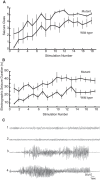Disruption of Fgf13 causes synaptic excitatory-inhibitory imbalance and genetic epilepsy and febrile seizures plus
- PMID: 26063919
- PMCID: PMC4461691
- DOI: 10.1523/JNEUROSCI.3470-14.2015
Disruption of Fgf13 causes synaptic excitatory-inhibitory imbalance and genetic epilepsy and febrile seizures plus
Abstract
We identified a family in which a translocation between chromosomes X and 14 was associated with cognitive impairment and a complex genetic disorder termed "Genetic Epilepsy and Febrile Seizures Plus" (GEFS(+)). We demonstrate that the breakpoint on the X chromosome disrupted a gene that encodes an auxiliary protein of voltage-gated Na(+) channels, fibroblast growth factor 13 (Fgf13). Female mice in which one Fgf13 allele was deleted exhibited hyperthermia-induced seizures and epilepsy. Anatomic studies revealed expression of Fgf13 mRNA in both excitatory and inhibitory neurons of hippocampus. Electrophysiological recordings revealed decreased inhibitory and increased excitatory synaptic inputs in hippocampal neurons of Fgf13 mutants. We speculate that reduced expression of Fgf13 impairs excitability of inhibitory interneurons, resulting in enhanced excitability within local circuits of hippocampus and the clinical phenotype of epilepsy. These findings reveal a novel cause of this syndrome and underscore the powerful role of FGF13 in control of neuronal excitability.
Keywords: Fgf13; GEFS+; animal model; epilepsy; excitatory inhibitory imbalance; translocation.
Copyright © 2015 the authors 0270-6474/15/358866-16$15.00/0.
Figures









References
-
- Banerjee P, Hauser W. Incidence prevalence. In: Engel J, Pedley T, editors. Epilepsy: a comprehensive textbook. Ed 2. Philadelphia: Wolters Kluwer Lippincott Williams & Wilkins; 2008. pp. 45–56.
-
- Cheah CS, Yu FH, Westenbroek RE, Kalume FK, Oakley JC, Potter GB, Rubenstein JL, Catterall WA. Specific deletion of NaV1.1 sodium channels in inhibitory interneurons causes seizures premature death in a mouse model of Dravet syndrome. Proc Natl Acad Sci U S A. 2012;109:14646–14651. doi: 10.1073/pnas.1211591109. - DOI - PMC - PubMed
Publication types
MeSH terms
Substances
Grants and funding
LinkOut - more resources
Full Text Sources
Medical
Molecular Biology Databases
